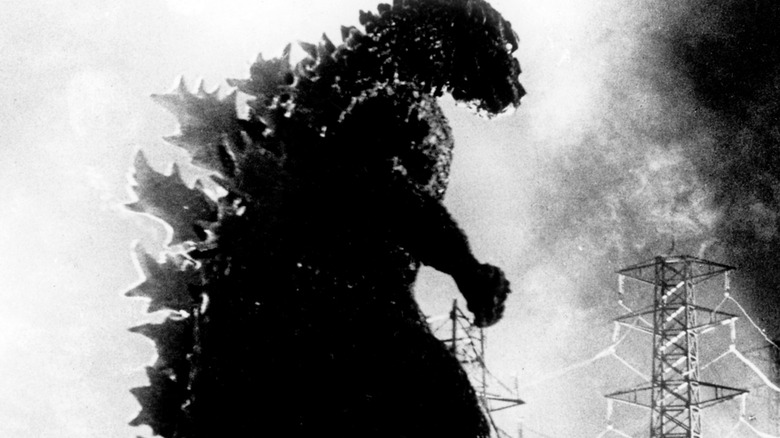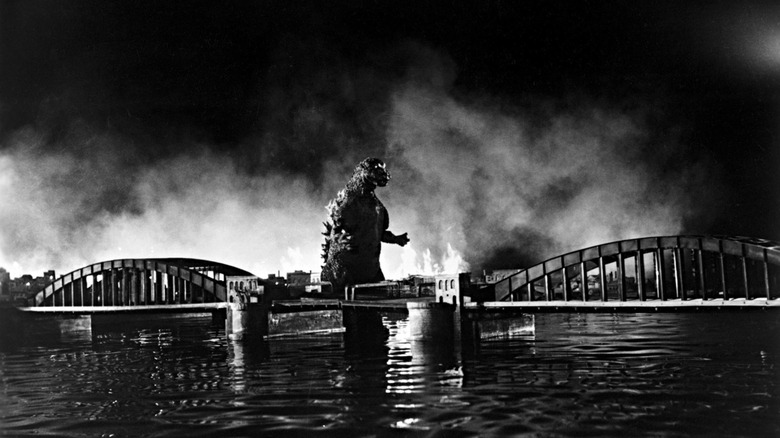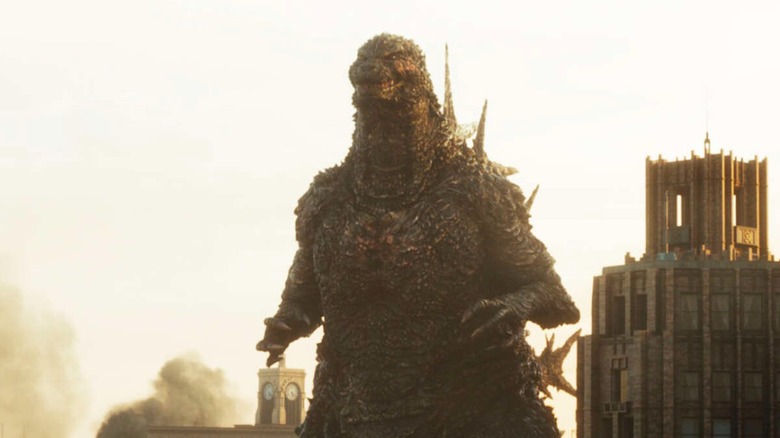Godzilla's Original Roar Came From Something Much Stranger Than An Animal
What's in a roar? Well, if it belongs to a ginormous prehistoric reptilian monster like Godzilla, it matters as much as what the creature represents or makes us feel. Godzilla's roar has evolved over the years — the original sound resembled a shrill "Skreeeonk!" as described in Dark Horse's "Godzilla" comics, and went on to alternate between deep, guttural sounds and high-pitched screeches that feel otherworldly. Akira Ifukube, who created the score for Ishirō Honda's "Godzilla" (and went on to work on several Toho-helmed Godzilla films, with "Godzilla vs. Destoroyah" being his final franchise collaboration), was the one who crafted the monster's distinctive disyllabic roar. This was not an easy task to accomplish, especially in 1954, when most creature sounds were created organically with minimal reliance on technological tweaks. How did Ifukube and Honda decide on a sound that would go on to constitute the heart and soul of such a beloved character?
For starters, Ifukube did not believe that Godzilla should roar at all, as the creature's reptilian origins in the film attest to this reasoning. In Honda's film, a hydrogen bomb displaces the ancient sea creature from its home, making it radioactive, which prompts it to become terrestrial and wreak havoc near Odo Island. However, Honda explained to him that Godzilla's ability to roar was a byproduct of his radioactive mutation, leading Ifukube to settle on an unusual musical instrument to create this sound. Due to a limited budget and the need to work with what was readily available, Ifukube decided on a half-broken contrabass lying on-site, as the device naturally emitted a low-pitched frequency that could be manipulated to sound like a raging monster. But, here's another catch: Ifukube decided not to play the instrument as one normally would, but extract the sound with far more unconventional means.
The birth of Godzilla's unforgettable roar
According to William M. Tsutsui's book "Godzilla on My Mind: Fifty Years of the King of Monsters," Ifukube grew up with folk musical influences that he channeled into his post-war work, and composed the iconic "Godzilla" theme (that is still used in films featuring the beast) in just one week. Tsutsui delves into Ifukube's process for creating the roar with the contrabass without traditionally playing the instrument:
"Ifukube was also responsible for Godzilla's unmistakable roar. After failing to produce anything convincing using recordings of wild animals, Ifukube made Godzilla's 'melancholy, ear-splitting cry' by drawing a leather glove across the strings of a contrabass and manipulating the resulting sound in an echo chamber. Ifukube also created the sonorous, haunting footfalls of the monster, though sources disagree on whether he used a Japanese taiko drum, a scratch-built amplifier, or the electronically altered sound of an explosion to complete the fantasy of Godzilla's resounding, mighty steps."
While there's some dispute regarding the exact method he used to produce the sound of Godzilla's footsteps, it is clear that Ifukube was especially gifted in drawing out sounds from disparate objects and bringing them together seamlessly. Per the composer's now-archived official website, Ifukube unwound the E-string of the contrabass and rubbed it vertically, which "produced a strange wail." This action was carried out by his assistant Sei Ikeno, who wore "leather gloves that were coated in thick, gluey pine tar" and produced these odd, guttural sounds. To grant the roar a final polish, animal sounds were layered on top of its recording and played at a speed that sounded the most authentic. The same roar was subsequently used as a base for the sounds of other monsters, including Varan, Baragon, and Gorosaurus.
How much has Godzilla's roar evolved?
While Godzilla's roar might sound vastly different in various iterations of the monster, Ifukube's ingeniously designed roar still serves as the blueprint for the altered cries of the beast. For instance, sound editors/designers Erik Aadahl and Ethan Van der Ryn, who created the creature's roar for Gareth Edwards' 2014 "Godzilla," took inspiration from the original roar by figuring out its musical key to get a better understanding of its pitch, cadence, and tone. Speaking to The Hollywood Reporter, the duo explained the process of using the 1954 roar to experiment with and arrive at their own rendition, with the intention of not doing "something completely different" but tweaking the original with the technology available at hand.
There has been a steady reliance on Ifukube's sound in prominent Toho films, such as in Hideaki Anno's "Shin Godzilla," which uses it in the creature's third form, while the fourth form uses the roars from several other Godzilla media, including "Terror of Mechagodzilla." Even the widely celebrated, Oscar-winning "Godzilla Minus One" uses an amplified version of the original roar, with some additional snarls added in to convey the feeling that the beast is akin to a weapon of mass destruction. Although Takashi Yamazaki's film focuses more on human suffering and perseverance, the roar is one of the many ways in which Godzilla becomes a terrifying source of incomparable power.
Ifukube's sound design for "Godzilla" persists because of its creative ingenuity, along with its ability to evoke emotions that encapsulate Godzilla's core spirit. Although his roar changes based on who Godzilla is supposed to be, the baseline remains the same: an otherworldly kaiju, whether a friend or foe, emerges as an awe-inspiring force of nature.
The roar will live on.


